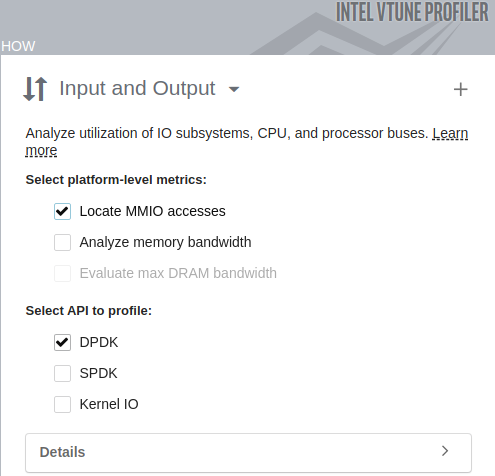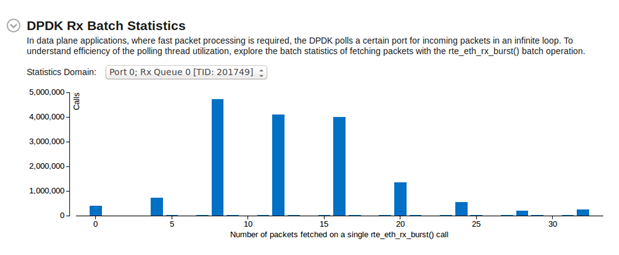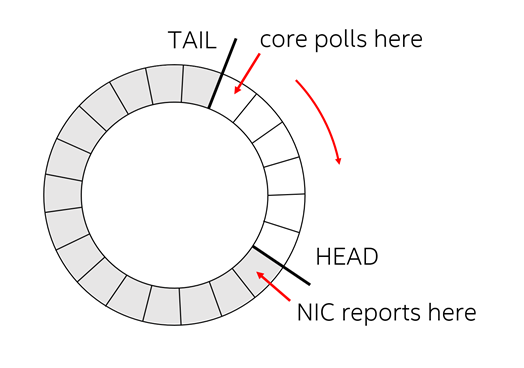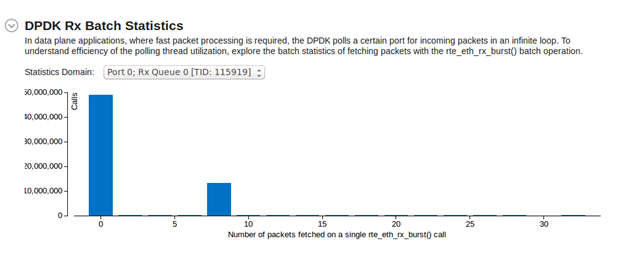Core Utilization in DPDK Apps
Explore metrics that characterize core utilization in terms of packet receiving in Data Plane Development Kit* (DPDK)-based applications.
In data plane applications where you require fast packet processing, the DPDK is supposed to poll a certain port for incoming packets in an infinite loop, pinned to a certain logical core. Such a polling model of packet retrieval poses the challenge of measuring effective core utilization. The CPU time on the core (where the polling loop is running) is always close to 100%, regardless of the many loop cycles when the DPDK runs idle. So, the CPU time cannot reflect how the core is utilized on the packet retrieval. However, for this polling model, the core utilization indicator might be Rx Spin Time - % of wasted polling loop cycles. Wasted Cycles are iterations during which the DPDK does not receive any packets.
Follow this recipe to analyze the efficiency of packet retrieval in a DPDK-based workload.
Content expert: Jeffrey Reinemann
Ingredients
Application: A DPDK testpmd application that runs on a single core and performs L2 forwarding. The application is compiled against DPDK with profiling support for VTune Profiler.
Tools:
DPDK with VTune Profiler profiling support enabled: DPDK versions 18.11 (and newer) include profiling support for VTune Profiler. When using earlier versions, apply the attached patches (available for versions 17.11, 18.02, and 18.05). To enable profiling on the DPDK side, enable the VTune Profiler to attach to the DPDK polling cycle. For this, reconfigure and recompile the DPDK (and the target application) with the CONFIG_RTE_ETHDEV_RXTX_CALLBACKS and CONFIG_RTE_ETHDEV_PROFILE_WITH_VTUNE flags enabled (located in the config/common_base config file).
Intel® VTune™ Profiler: Input and Output analysis
Operating system: Test system that consists of the traffic generator (GEN in the picture below) providing 64-byte frames and packet receiver (SUT - system under test), connected via 40 GbE link. The SUT performs L2 forwarding of packets.

CPU: Intel® Xeon® Platinum 8180 (38.5M Cache, 2.5 GHz, 28 cores)
Run Input and Output Analysis
To run DPDK analysis, select the and enable in the :
- Open the VTune Profiler GUI.
- From the Analysis Tree, select Input and Output analysis.
- Under Select API to profile, select the DPDK option.

You can correlate API-specific metrics, such as DPDK Rx Spin Time, with the hardware events and hardware event-based metrics. For example, you can see the dependency between DPDK Rx Spin Time and PCIe bandwidth that can be collected when the Locate MMIO accesses option is enabled.
To run Input and Output analysis with PCIe bandwidth and DPDK metrics from command line, execute the following command as a root, which enables getting per-device PCIe bandwidth with human-readable names:
Analyze Core Utilization with the DPDK Rx Spin Time Metric
When the data is collected, start your analysis with the Platform tab and explore the DPDK Rx Spin Time overtime metric that refers to a thread. This metric shows (on a per-thread basis) a portion of rte_eth_rx_burst(...) function calls that return zero packets, which is identical to the fraction of polling loop iterations that provide no packets:


The result demonstrated in this recipe is synthetic.
On the Platform view above, the CPU Time (brown) for the polling thread is always close to 100%. The DPDK Rx Spin Time (red) illustrates thread utilization in terms of packet retrieving. Hover the mouse over the charts to find values at each moment of time in the tooltip.
In this example, the traffic generator was automated to increase the traffic rate every two seconds by 5% of 40 Gbps and collect packet loss data. Overtime data written to a properly formatted *.csv file can be imported to a VTune Profiler project and visualized on its timeline.
By default, VTune Profiler cannot collect the Packet Rate and Packet Loss metrics displayed in the Global Counters section above. For this recipe, these metrics were collected separately and manually imported to the result collected by the VTune Profiler. As an alternative, you can use the custom collector feature in VTune Profiler to import a csv file with additional metrics. The custom collector is an additional process executed by VTune Profiler when the collection starts, stops, or pauses. You can use the custom collector to implement all the system automation and collect additional metrics. This makes the experiment reproducible and results valid for comparison, which is useful for consequential performance tuning.
At the bottom of the Platform view, you can see how the Inbound PCIe Bandwidth was changing over time. Since the analysis was run on the Intel microarchitecture code named Skylake with root privileges, PCIe Bandwidth is broken into PCIe devices with human readable names.
All metrics in the Platform view above are correlated. As the traffic generation rate grows, the Inbound PCIe Bandwidth increases and DPDK Rx Spin Time goes down. At some point, the test system gets overloaded and a non-zero Packet Loss value shows up.
If a thread processes several Rx Queues, the DPDK Rx Spin Time metric will represent composite statistics.
Analyze Packets Retrieval with DPDK Rx Batch Statistics Histogram
DPDK uses the rte_eth_rx_burst(...) function to receive batches of packets from the NIC. It can retrieve any number of packets in the interval (0, MAX_NB_PKTS) , where MAX_NB_PKTS is a constant value (typically, 32). Hence, with the fixed Rx Spin Time, the core may process far different traffic, so Rx Spin Time does not represent a full picture.
To see summary statistics for packet retrieving and get a full characterization of core utilization on Rx, switch to the Summary tab and explore the DPDK Rx Batch Statistics histogram:

This histogram represents statistics on receiving batch packets for the selected Port / Rx Queue / TID grouping. In this example, all the peaks show values multiple of 4. This is not a coincidence and the root cause investigation requires understanding the background of the packet receiving.
Understand Rx Operations and Investigate Rx Peaks
To receive packets, the working core communicates with the NIC through the Rx descriptors that are data structures keeping the information about the packet, such as its address, size, and so on. The Rx descriptors are joint into ring buffers called Rx Queues. In simple terms, the packet receiving is the race in the ring buffer, where the NIC fills in the Rx descriptors from the ring buffer Head and working core polls, processes and frees Rx descriptors coming from the Tail:

When the core frees Rx descriptors, it moves the Tail pointer forward. When the Tail reaches the Head, rte_eth_rx_burst() can return 0 packets. In the opposite case, when the Head reaches the Tail, there are no free Rx descriptors in the Rx Queue and packet loss may occur.
To deliver a new packet, the NIC reads the Rx descriptor in the Head of the Rx Queue and transfers the packet to the memory by the address specified by the core in the descriptor. Then, it has to write back the Rx descriptor to notify the core on the new packet arrival.
Intel® Ethernet Controller XL710, used in the recipe setup, supports 16 and 32 Byte Rx descriptors. Both are less than the cache line size, therefore the NIC has the descriptor write back policy denoting that NIC should coalesce writes by packing Rx descriptors into the integer number of cache lines to save PCIe bandwidth. Primarily, the XL710 writes back completed Rx descriptors when the following requirements are met:
4 x 32 Byte descriptors or 8 x 16 Byte descriptors are completed.
A descriptor is invalidated in the internal NIC cache.
Refer to the Intel Ethernet Controller X710/ XXV710/XL710 Datasheet for more details.
In this recipe, the system employed 32 Byte Rx descriptors. That is why most peaks of the DPDK Rx Batch Histogram mark values in multiple of 4.
DPDK allows toggling the Rx descriptor size. These DPDK Rx Batch Histogram diagrams describe the changes that happen when running testpmd with 32 and 16 Byte Rx descriptors under medium load:
32 Byte Rx descriptor: Most of rte_eth_rx_burst() calls receive 4 packets.

16 Byte Rx descriptor: Most of rte_eth_rx_burst() calls receive 8 packets.
